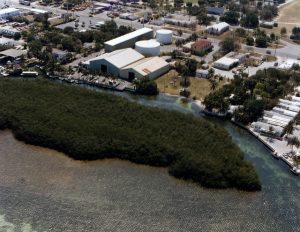
Aerial of Islamorada Library on Upper Matecumbe Key. Photo taken by the Federal Government on October 7, 1987. From the Wright Langley Collection.
The name of Upper Matecumbe Key & Lower Matecumbe Key has been used at different times to designate both keys. Upper Matecumbe Key is the location of the original settlement site of Islamorada. There are some Indian mounds and habitation sites located here.
In 1908, the first Islamorada post office was opened. Families usually lived on the ocean side of the Key for the better breeze, access to ocean transportation and fewer mosquitoes. The railroad depot was a full-service base complete with telegraph, railway express and waiting room.
On the north end of Upper Meta-combe Key, a new town known as Isle Morada has sprung into existence. It is an ideal spot on the Key West Extension and has a beautiful waterfront on the bay side. Matecumbe was often spelt Matacumbe in earlier days.
Most of the settlement of Matecumbe remained on the ocean side. It encompassed from about where the Cheeca Lodge is located and to the south end of the island. Sand had built up along the beach, so 8 to 10 feet of ground elevation was easily found. The 1935 hurricane spread the sand around more or less as one finds it today.
With the coming of the first overseas highway (1928), more resorts appeared in the Keys, such as the Matecumbe Hotel known then as the Russell Arms Hotel.
Upper Matecumbe has the largest concentration (19) of what are referred to as “Red Cross” or “Conch Houses” houses. There are 18 concrete houses, two of wood, two business buildings with the cooperation of the Red Cross and the Florida Emergency Relief Administration (FERA). Built especially strong, they provided habitat for Keys families who lost their homes in the 1935 hurricane.
Historical names include Little Matecumbe, Matacombe la Mosa, Matacunbe Nuevo, Matecumbe (el/la) Viejo, Matecumbe el Grande, Matecunbe Nuebo, New Matecumbe and Young Matacomb.